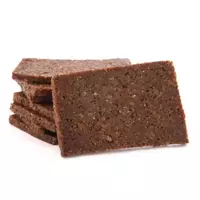Pumpernickel bread

Did you know that rye bread has long been in stable demand and popularity not only in the territory of the Russian Federation and the countries that were once part of the USSR. Analogues of domestic Borodino bread can be found, for example, in Germany, where original bread with an equally distinctive name - pumpernickel has long been baked. Pumpernickel bread is a bakery product that is made from rye flour, necessarily coarse grinding.
The main feature and unique benefit of pumpernickel bread lies in the content of non-ground rye grains or folkornbrot in the bakery product. Pumpernickel bread is considered an indispensable attribute of Westphalian cuisine. Westfaoia is a historical region that is located in the northwestern states of Germany. It is noteworthy that the history of unusual pumpernickel bread began back in the early Middle Ages, when medicines began to use the product in healing products.
It was believed that pumpernickel bread has a favorable effect on the digestive system of the human body. Nowadays, the useful properties of pumpernickel bread have found scientific confirmation and justification. For this reason, nutritionists advise people with impaired metabolism or problems with the digestive tract to eat pumpernickel bread. Researchers have found mention of pumpernickel bread dating from the early Middle Ages.
However, the first and oldest bakery for the production of pumpernickel bread was opened only in 1570 in the city of Zost. It is believed that until the 16th century, pumpernickel bread was produced only at home or in one region of Westphalia. However, over time, the distinctive taste, and in addition, the consumer characteristics of pumpernickel bread were liked not only by all residents of German lands without exception, but also by the peoples inhabiting neighboring states.
Researchers have not yet come to a consensus about the origin of the original name of the bread. Some German scientists believe that the name of pumpernickel bread is associated with the beneficial properties of the product, which help with constipation, as well as impaired digestion. However, some researchers support the famous German history of Debler, who claims that the word pumpernickel was once associated with diabolical sinister tricks.
During the famous "witch hunt, " which remembered medieval Europe, they began to call dark black rye bread pumpernickel. By the end of the 17th century, the word pumpernickel was associated exclusively with the name of rye bread. For making pumpernickel bread, rye flour of coarse grinding is used. In addition, whole rye grains are necessarily added to pumpernickel bread. It is noteworthy that before making bread pumpernickel, rye grains should be soaked in water all night, and always hot.
In the morning, dough for bread is kneaded, whole rye grains are added and baked at a temperature of 200S. It is noteworthy that pumpernickel bread is baked for a long time, gradually reducing the temperature in the 200S to 100S. Ultimately, pumpernickel bread flows out within 24 hours. Such a long process of making pumpernickel bread helps to preserve as many useful natural compounds as possible in the composition of finished bakery products.
However, in industrial production, the old method of making pumpernickel bread has not been used for a long time. By the way, pumpernickel bread prepared according to a traditional recipe and packaged in sealed packaging can maintain its taste and consumer parameters throughout the year.
pumpernickel bread 250 kCal
Energy value of pumpernickel bread (Ratio of proteins, fats, carbohydrates - ju):
Proteins: 8.7 g (~ 35 kCal)
Fats: 3.1 g (~ 28 kCal)
Carbohydrates: 41g (~ 164kCal)
Energy ratio (b | y): 14% | 11% | 66%
 Español
Español Français
Français Português
Português Русский
Русский 简体中文
简体中文 繁體中文
繁體中文 日本語
日本語 한국어
한국어 العربية
العربية Türkçe
Türkçe Қазақ
Қазақ Deutsch
Deutsch Italiano
Italiano Українська
Українська
